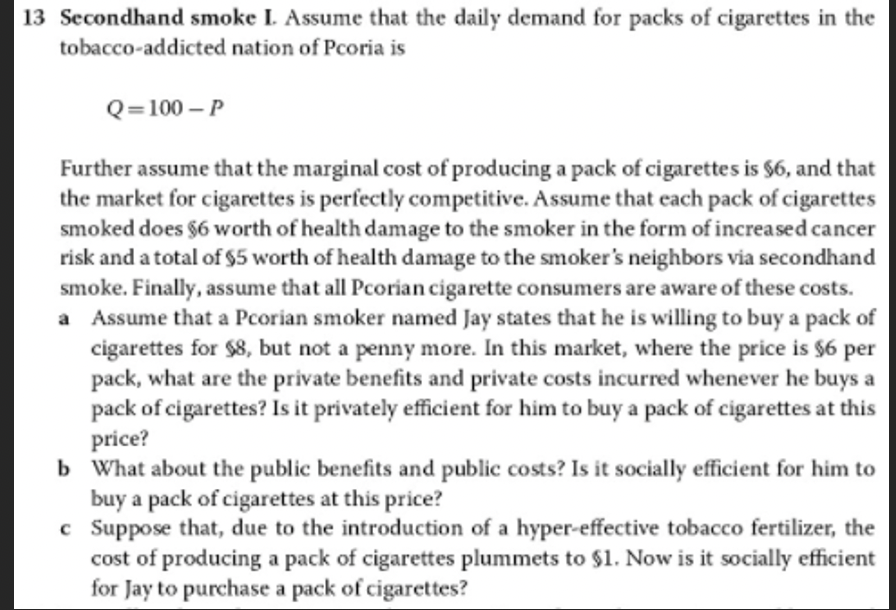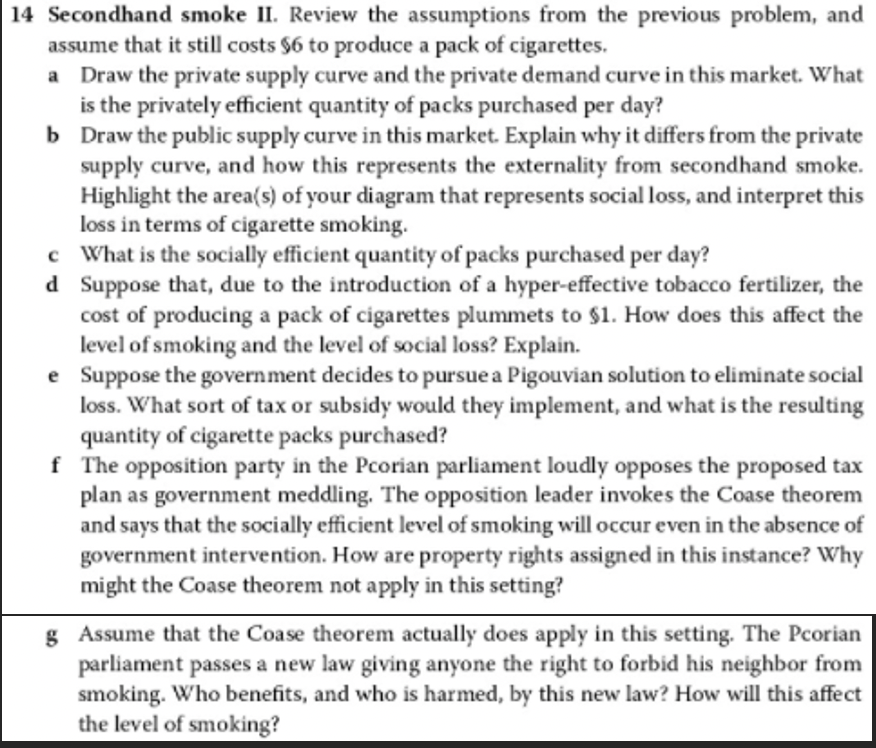13 Secondhand smoke L Assume that the daily demand for packs of cigarettes in the- tobacco-addicted nation of Pcoria is Q=100 – P Further assume that the marginal cost of producing a pack of cigarettes is $6, and that the market for cigarettes is perfectly competitive. Assume that each pack of cigarettes smoked does §6 worth of health damage to the smoker in the form of increased cancer risk and a total of 65 worth of health damage to the smoker's neighbors via secondhand
13 Secondhand smoke L Assume that the daily demand for packs of cigarettes in the- tobacco-addicted nation of Pcoria is Q=100 – P Further assume that the marginal cost of producing a pack of cigarettes is $6, and that the market for cigarettes is perfectly competitive. Assume that each pack of cigarettes smoked does §6 worth of health damage to the smoker in the form of increased cancer risk and a total of 65 worth of health damage to the smoker's neighbors via secondhand
Chapter17: Income, Poverty, And Health Care
Section: Chapter Questions
Problem 18P
Related questions
Question
second photo only please, # 14. only Thakyou!!

Transcribed Image Text:13 Secondhand smoke L Assume that the daily demand for packs of cigarettes in the
tobacco-addicted nation of Pcoria is
Q=100 – P
Further assume that the marginal cost of producing a pack of cigarettes is $6, and that
the market for cigarettes is perfectly competitive. Assume that each pack of cigarettes
smoked does §6 worth of health damage to the smoker in the form of increased cancer
risk and a total of $5 worth of health damage to the smoker's neighbors via secondhand
smoke. Finally, assume that all Pcorian cigarette consumers are aware of these costs.
a Assume that a Pcorian smoker named Jay states that he is willing to buy a pack of
cigarettes for $8, but not a penny more. In this market, where the price is $6 per
pack, what are the private benefits and private costs incurred whenever he buys a
pack of cigarettes? Is it privately efficient for him to buy a pack of cigarettes at this
price?
b What about the public benefits and public costs? Is it socially efficient for him to
buy a pack of cigarettes at this price?
c Suppose that, due to the introduction of a hyper-effective tobacco fertilizer, the
cost of producing a pack of cigarettes plummets to $1. Now is it socially efficient
for Jay to purchase a pack of cigarettes?

Transcribed Image Text:14 Secondhand smoke II. Review the assumptions from the previous problem, and
assume that it still costs $6 to produce a pack of cigarettes.
a Draw the private supply curve and the private demand curve in this market. What
is the privately efficient quantity of packs purchased per day?
b Draw the public supply curve in this market. Explain why it differs from the private
supply curve, and how this represents the externality from secondhand smoke.
Highlight the area(s) of your diagram that represents social loss, and interpret this
loss in terms of cigarette smoking.
c What is the socially efficient quantity of packs purchased per day?
d Suppose that, due to the introduction of a hyper-effective tobacco fertilizer, the
cost of producing a pack of cigarettes plummets to $1. How does this affect the
level of smoking and the level of social loss? Explain.
e Suppose the government decides to pursue a Pigouvian solution to eliminate social
loss. What sort of tax or subsidy would they implement, and what is the resulting
quantity of cigarette packs purchased?
f The opposition party in the Pcorian parliament loudly opposes the proposed tax
plan as government meddling. The opposition leader invokes the Coase theorem
and says that the socially efficient level of smoking will occur even in the absence of
government intervention. How are property rights assigned in this instance? Why
might the Coase theorem not apply in this setting?
g Assume that the Coase theorem actually does apply in this setting. The Pcorian
parliament passes a new law giving anyone the right to forbid his neighbor from
smoking. Who benefits, and who is harmed, by this new law? How will this affect
the level of smoking?
Expert Solution
This question has been solved!
Explore an expertly crafted, step-by-step solution for a thorough understanding of key concepts.
This is a popular solution!
Trending now
This is a popular solution!
Step by step
Solved in 2 steps with 2 images

Knowledge Booster
Learn more about
Need a deep-dive on the concept behind this application? Look no further. Learn more about this topic, economics and related others by exploring similar questions and additional content below.Recommended textbooks for you

Exploring Economics
Economics
ISBN:
9781544336329
Author:
Robert L. Sexton
Publisher:
SAGE Publications, Inc



Exploring Economics
Economics
ISBN:
9781544336329
Author:
Robert L. Sexton
Publisher:
SAGE Publications, Inc

